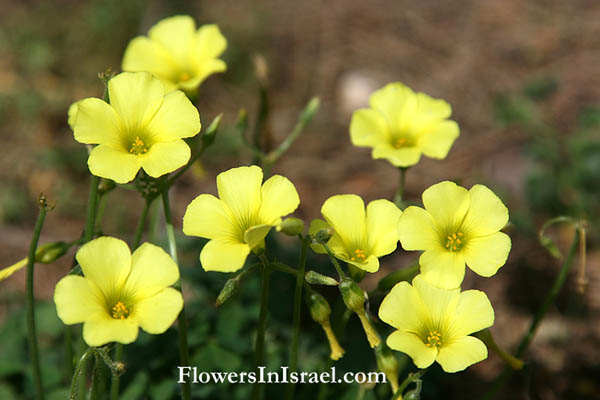

Oxalis cernua is a less common synonym for this species. Oxalis pes-caprae ( African wood-sorrel, Bermuda buttercup, Bermuda sorrel, buttercup oxalis, Cape sorrel, English weed, goat's-foot, sourgrass, soursob or soursop Afrikaans: suring ) is a species of tristylous yellow-flowering plant in the wood sorrel family Oxalidaceae.
Acetosella ehrenbergii (Schltdl.) Kuntze. USDA PLANTS Database - Information on identification and distribution, with links to websites in individual states. Jepson Interchange - Information on this plant's taxonomy, biology, and distribution from UC Berkeley's Jepson Herbarium. EDDMapS - Distribution of this species in North America. CalWeedMapper - Distribution map of this species in California with ability to determine regional priorities. Calflora - Distribution map and records of this species in California. CalPhotos - Images of plants taken mostly in California. Bugwood - National database from the Center for Invasive Species and Ecosystem Health at the University of Georgia. 
Management of Bermuda buttercup (Oxalis pes-caprae) in the Peninsula Watershed of the San Francisco Public Utilities Commission.Reed, Lewis Olarnik, Suzanne Hyland, Tim ( 2017)
 Management of a coastal bluff community invaded by Oxalis pes-caprae with low concentrations of glyphosate. Mapping weeds and rare plants to inform management and conservation in the Zaca and Jesusita fires.Ĭalloway, Stephanie Schneider, Heather Knapp, Denise ( 2018). Where a presentation is not available, find more information by reading the abstract in the Cal-IPC Symposia Archive. Presentations are linked where available. Portrait of an invader II: The ecology and management of Carpobrotus edulis.
Management of a coastal bluff community invaded by Oxalis pes-caprae with low concentrations of glyphosate. Mapping weeds and rare plants to inform management and conservation in the Zaca and Jesusita fires.Ĭalloway, Stephanie Schneider, Heather Knapp, Denise ( 2018). Where a presentation is not available, find more information by reading the abstract in the Cal-IPC Symposia Archive. Presentations are linked where available. Portrait of an invader II: The ecology and management of Carpobrotus edulis. 
Management Notes - Information on management techniques and effectiveness from the University of California Cooperative Extension’s Weed Research & Information Center. Plant Assessment Form - Information gathered by Cal-IPC on the impacts, rate of spread, and distribution of invasive plants in California. * – An asterisk next to the rating indicates that a plant is included in the CCR Section 4500 list of California State Noxious Weeds. D – An organism known to be of little or no economic or environmental detriment, to have an extremely low likelihood of weediness, or is known to be a parasite or predator. C – A pest of known economic or environmental detriment and, if present in California, it is usually widespread. B – A pest of known economic or environmental detriment and, if present in California, it is of limited distribution. A – A pest of known economic or environmental detriment and is either not known to be established in California or it is present in a limited distribution that allows for the possibility of eradication or successful containment. Watch – These species have been assessed as posing a high risk of becoming invasive in the future in California. Alert – An Alert is listed on species with High or Moderate impacts that have limited distribution in California, but may have the potential to spread much further. Ecological amplitude and distribution are generally limited, but these species may be locally persistent and problematic. Their reproductive biology and other attributes result in low to moderate rates of invasiveness. Limited – These species are invasive but their ecological impacts are minor on a statewide level or there was not enough information to justify a higher score. Ecological amplitude and distribution may range from limited to widespread. Their reproductive biology and other attributes are conducive to moderate to high rates of dispersal, though establishment is generally dependent upon ecological disturbance. Moderate – These species have substantial and apparent-but generally not severe-ecological impacts on physical processes, plant and animal communities, and vegetation structure. Most are widely distributed ecologically. Their reproductive biology and other attributes are conducive to moderate to high rates of dispersal and establishment. High – These species have severe ecological impacts on physical processes, plant and animal communities, and vegetation structure.








 0 kommentar(er)
0 kommentar(er)
